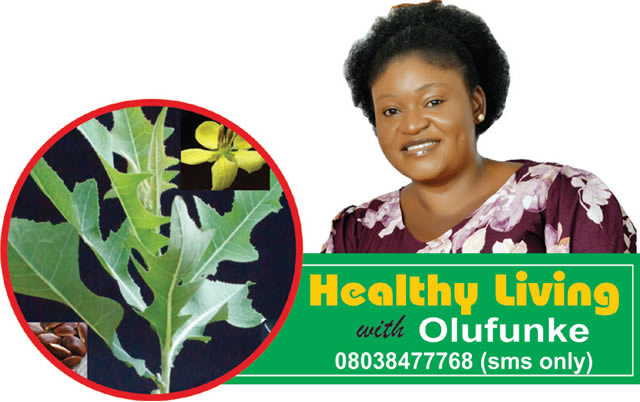Sugar substitute: Stevia (2)
Olufunke Faluyi
The United States Food and Drug Administration does not recognise raw or whole stevia like your home grown Stevia, they approved only the highly purified steviol glycosides from stevia leaves as safe to use and are called “generally recognized as safe”. Increasingly, the approved ones are being found to contain counterfeit ingredients, primarily artificial sweeteners that are linked to known health risks. What do we do?
Over the week, I was busy receiving chats and calls from readers who needed Stevia plants to grow in their homes. It made me so happy that people are becoming so concerned about their health.This week will be dedicated to discussions on which is safer between home grown Stevia and store- bought ones.We will use some researches as case studies.
Years ago, I bought a pack of stevia. I noticed it was white like sugar.That showed it was bleached. After all ,it was made from leaves and leaves are green.Thoughts that during processing, it would have been ripped off of most of its nutrients really put me off. I never bought another.
Are these approved stevia really safe?That is what we are about to find out.I stumbled on a scientific research by Alyaa Farid et al. It is titled “The hidden hazardous effects of stevia and sucralose consumption in male and female albino mice in comparison to sucrose”.The study aims to evaluate the effects of sucralose as an artificial sweetener and stevia as a natural one on blood biochemical parameters, enzyme activities and immunological parameters in experimental male and female albino mice. Furthermore, liver and kidney sections from all experimental groups were subjected to histopathological examination.The study also aimed to compare the effects of sucralose and Stevia to those of sucrose to evaluate their safety as sugar substitutes.
In all scientific researches, the materials and methods used are always stated, so in this research, the brands of Sucralose and Stevia used were mentioned but I will not disclose the brand names.
The conclusion of the study read “In conclusion, non-caloric sweeteners either artificial (sucralose) or natural (stevia) hide several risks to their consumers. They are responsible for: 1- increasing glycaemia in spite of their lack of calories, 2- increasing liver enzymes due to the intestinal flora reshaping, 3- elevation of urea and creatinine levels, 4- reduction of the anti-inflammatory cytokines and elevation of the pro-inflammatory cytokines secretion. On the other hand, sucrose is a caloric sweetener with some risks of course; but it is safer than sucralose or stevia. So, we recommend not using sucralose or stevia and decreasing the used daily dose of sucrose instead”
A store- bought Stevia and not a home- grown one was used in this research. Now, let us analyse the conclusion of the research. Number 1 says “They are responsible for increasing glycaemia in spite of their lack of calories”.The truth is that whole leaf or raw Stevia ( like your home grown Stevia) will never raise blood glucose or insulin levels.So, it does not cause hyperglycemia (high blood sugar). For the brand of stevia used in this research to have caused hyperglycemia, it means it has added sweetener.
There is a big difference between the stevia you buy at the grocery store and the stevia you may grow at home. Many varieties in the market are highly refined and combined with other sweeteners like erythritol, dextrose and maltodextrin which may alter its potential health effects. Although, stevia is considered safe for people with diabetes, brands that contain dextrose or maltodextrin should be treated with caution.Dextrose is glucose and maltodextrin is a starch.These ingredients add small amounts of carbs and calories. Sugar alcohols may also slightly tip the carb count.
In a first-of-its-kind study, Dr. Kohli, MBBS, MS, addressed and answered the question: Can non-caloric sweeteners improve signs of fatty liver disease? Let us use Dr. Kohli’s findings to solve the riddle posed in conclusion number 2 that says “they are responsible for increasing liver enzymes due to the intestinal flora reshaping”. The results of Dr. Kohli’s study were striking. According to him, “We compared these sweeteners (sucralose and stevia extract) head to head with sugar, Stevia extract lowers glucose levels and improves markers of fatty liver disease.” These markers include fibrosis and fat levels in the liver.So, Stevia does not harm the liver. As usual, the materials and method used in Dr. Kohli’s study were stated.This time, a whole, organic Stevia was used!
Let us look at conclusion number 3 which says “they are responsible for elevation of urea and creatinine levels” This has to do with the kidney. As you read on, you will see a research done on how Stevia improved chronic kidney disease.
The first research used a brand of stevia with added sweetener and the results did not do justice to Stevia at all. Infact it was recommended that people should not use Stevia but go back to sugar and reduce its usage.The other research used a whole, organic Stevia and the results were great.
According to Jen Messer, a nutrition consultant and registered dietitian at Jen Messer Nutrition, “Stevia also has the benefit of having “a low impact on blood sugar levels, making it a sought-after option for people managing diabetes” Because of many of its known advantages, she says, “if my clients are looking for a natural and low-calorie sweetener, I tell them that stevia is a good option”.
A study titled Preliminary analysis of the effect of Stevia (Stevia rebaudiana) in patients with chronic kidney disease (stage I to stage III) Farhana Rizwan et al concludes that the initial result demonstrated that Stevia has the potential for a significant improvement of some biochemical parameters in CKD patients.
A study titled Antioxidant Activity of Leaf Extracts from Stevia rebaudiana Bertoni Exerts Attenuating Effect on Diseased Experimental Rats: A Systematic Review and Meta-Analysis by Maria Papaefthimiou et al concludes that stevia leaf extract can act protectively against various diseases.
A study titled Stevia as a Natural Sweetener: A Review by Balakrishnan Arumugam et al concludes that the leaves of stevia with enriched phyto-constituents could be an alternative natural sweetener for children, adults and old age persons who have a craze to drink beverages and eat sweetened food products in their habitual life.
Stevia is great for the skin. Applied topically, it can aid in healing cuts or sores on the body, lips or within the mouth. It is effective in healing numerous skin problems, as well as softening the skin and reducing wrinkles when used as a skin or facial mask.
A single crushed stevia leaf in a hot cup of tea will bring a sweet taste.You can also grind dried stevia leaves into a fine powder and use to sweeten your foods. Like I always say, every herb should be used in moderation.When you finally plant Stevia in your home, do not abuse the usage.You won’t even need to use as much as sugar because it is sweeter.
I think the United States Food and Drug Administration should start approving whole leaf Stevia. For me, it is safer!











